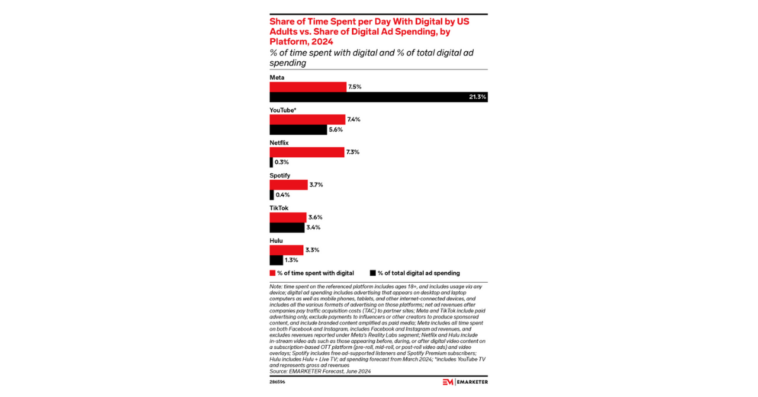Meta Platforms Inc. continues to dominate the digital advertising landscape, with its share of ad spending on digital platforms vastly surpassing the time users spend on its services. This growing disparity highlights a significant trend in the digital advertising industry and sheds light on Meta’s strategic advantages over its competitors.
In the ever-evolving realm of digital advertising, Meta stands out for its remarkable ability to capture a disproportionate share of advertising revenue relative to the time users spend on its platforms. As of August 2024, Meta’s share of digital ad spend is nearly three times the amount of time users allocate to its platforms, according to eMarketer. This statistic underscores Meta’s substantial influence in the advertising sector, despite users’ increasing concerns about the saturation of ads on its services, such as Instagram and Facebook.
The data reveals that Meta is poised to capture a staggering 21.3% of the total digital ad spend in the United States this year. In contrast, platforms like YouTube and Netflix, which collectively account for a significant portion of digital time spent by consumers, will see far less ad spend directed their way. YouTube, for instance, is projected to receive just 5.6% of the digital ad dollars, while Netflix is expected to attract a mere 0.3%. This discrepancy highlights Meta’s unique position in the digital advertising market, where its platforms—despite relatively similar user engagement levels compared to its competitors—command a much larger share of ad revenue.
One of the key factors contributing to Meta’s dominance is its ability to deliver trackable return on investment (ROI) and streamlined ad placements. Advertisers appreciate Meta’s sophisticated targeting capabilities and the ability to measure ad performance with high precision, which enhances the effectiveness of their advertising spend. This efficient advertising environment has helped Meta secure a substantial share of the digital ad budget, even as user complaints about ad overload persist.
In contrast, the advertising spend on connected TV (CTV) platforms like Netflix and YouTube has not kept pace with the shift in consumer behavior from traditional linear TV to digital streaming. Despite the considerable amount of time consumers spend on these platforms, the ad revenue generated from CTV has not mirrored this engagement. The industry’s slow adaptation to the changing landscape of digital consumption has left a gap that Meta has effectively exploited.
The data from the second quarter of 2024 reflects Meta’s continued growth, with a 7% increase in the number of users across its apps and a 10% rise in both ad impressions and ad prices. This robust performance indicates that Meta’s ad revenue model remains highly effective, even as consumers’ ad fatigue grows. The company’s ability to attract and retain advertisers through its powerful analytics and ad placement tools has reinforced its position as a leading player in the digital advertising space.







Comments
Loading…